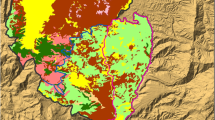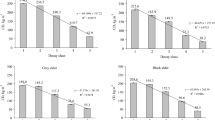Abstract
Context
Deadwood is an important habitat for vertebrate and invertebrate species, a key factor in the nutrient cycle and a valuable carbon pool. Difference in the deadwood C stock depends on many variables such as forest type, microclimate and forest management.
Aims
We investigated the relationship between C stock in deadwood and forest management in oak stands of southern Italy.
Methods
Deadwood C stock was quantified in 74 forest stands under intensive, extensive or multifunctional management. The relationship between management and C stock in deadwood was assessed taking into account the decay class and the type of deadwood (snags, stumps and logs).
Results
Intensively managed forests are characterized by significantly lower mean levels of deadwood C than the other forms of management. Multifunctional management resulted in the highest level of C, mainly in logs and snags, while extensive management resulted in high levels of C storage concentrated in snags.
Conclusion
Results of the research highlight that forest management practices greatly influence the quantitative and qualitative presence of deadwood in forests.




Similar content being viewed by others
References
Barreca L, Cutini A, Mercurio R (2008) Caratterizzazione della necromassa in boschi di farnetto (Quercus frainetto Ten.) della Calabria. Forest 5:187–194
Bobiec A (2002) Living stands and dead wood in the Białowieża forest: suggestions for restoration management. For Ecol Manag 165:125–140
Bragg DC, Kershner JL (1999) Coarse woody debris in riparian zones. J For 4:30–35
Brown S (2002) Measuring carbon in forests: current status and future challenges. Environ Pollut 116:363–372
Cannell MGR (1984) Woody biomass of forest stands. For Ecol Manag 8:299–312
Coomes DA, Allen RB, Sčoty NA, Goulding C, Beets P (2002) Designing systems to monitor carbon stocks in forests and shrublands. For Ecol Manag 164:89–108
Costantini G, Bellotti A, Mancino G, Borghetti M, Ferrara A (2006) Carta Forestale della Basilicata. INEA
Di Cosmo L, Gasparini P, Paletto A, Nocetti M (2013) Deadwood basic density values for national-level carbon stock estimates in Italy. For Ecol Manag 295:51–58
Duvall MD, Grigal DF (1999) Effects of timber harvesting on coarse woody debris in red pine forests across the Great Lakes states, U.S.A. Can J For Res 29:1926–1934
EEA (2006) European forest types. EEA Technical Report 9, Luxembourg, 111 p
FAO (2004) Global Forest Resources Assessment Update 2005. Terms and definitions. FRA Programme Working Paper 83/E, Rome, 35 p
Fridman J, Walheim M (2000) Amount, structure, and dynamics of dead wood on managed forestland in Sweden. For Ecol Manag 131:23–36
Führer E (2000) Forest functions, ecosystem stability and management. For Ecol Manag 132:29–38
Green P, Peterken GF (1997) Variation in the amount of dead wood in the woodlands of the Lower Wye Valley, UK in relation to the intensity of management. For Ecol Manag 98:229–238
Hagemann U, Moroni MT, Makeschin F (2009) Deadwood abundance in Labrador high-boreal black spruce forests. Can J For Res 39:131–142
Harmon ME, Franklin JF, Swanson FJ, Sollins P, Gegory SW, Lattin JD, Anderson NH, Cline SP, Aumen NG, Sedell JR, Lienkaemper GW, Cromak K, Cummins KW (1986) Ecology of coarse woody debris in temperate ecosystems. Adv Ecol Res 15:133–302
Helms JA (1998) The dictionary of forestry. Society of American Foresters, Washington
Herrero C, Krankina O, Monleon VJ, Bravo F (2014) Amount and distribution of coarse woody debris in pine ecosystem of north-western Spain, Russia and the United States. IForest 7:53–60
Holub SM, Spears JDH, Lajtha K (2001) A reanalysis of nutrient dynamics in coniferous coarse woody debris. Can J For Res 31:1894–1902
Hunter ML (1990) Wildlife, forests and forestry. Prentice Hall, Englewood Cliffs
INFC (2007) Le stime di superficie 2005. Autori: Tabacchi G, De Natale F, Di Cosmo L, Floris A, Gagliano C, Gasparini P, Genchi L, Scrinzi G, Tosi V, Inventario Nazionale delle Foreste e dei Serbatoi Forestali di Carbonio. MiPAF–Corpo Forestale dello Stato - Ispettorato Generale, CRA - ISAFA, Trento. Available at: http://www.infc.it
Jönsson MT, Jonsson BG (2007) Assessing coarse woody debris in Swedish woodland key habitats: implications for conservation and management. For Ecol Manag 242:363–373
Kirby KJ, Reid CM, Thomas RC, Goldsmith FB (1998) Preliminary estimates of fallen dead wood and standing dead trees in managed and unmanaged forests in Britain. J Appl Ecol 35:148–155
Krankina ON, Harmon ME (1994) The impact of intensive forest management on carbon stores in forest ecosystems. World Res Rev 6:161–177
Kruys N, Fries C, Jonsson BG, Lämås T, Ståhl G (1999) Wood-inhabiting cryptogams on dead Norway spruce (Picea abies) trees in managed Swedish boreal forests. Can J For Res 29:178–186
Kueppers LM, Southon J, Baer P, Harte J (2004) Dead wood biomass and turnover time, measured by radiocarbon, along a subalpine elevation gradient. Oecologia 141:641–651
La Fauci A, Mercurio R (2008) Caratterizzazione della necromassa in cedui di castagno (Castanea sativa Mill.) in Aspromonte. Forest 5:92–99
Lombardi F, Lasserre B, Tognetti R, Marchetti M (2008) Deadwood in relation to stand management and forest type in Central Apennines (Molise, Italy). Ecosyst 11:882–894
Marage D, Lemperiere G (2005) The management of snags: a comparison in managed and unmanaged ancient forests of the Southern french Alps. Ann For Sci 62:135–142
Marchetti M, Lombardi F (2006) Analisi quali-quantitativa del legno morto in soprassuoli non gestiti: il caso di “Bosco Pennataro”, Alto Molise. L’Italia Forestale e Montana 4:275–301
Mason F, Nardi G, Whitmore D (2005) Recherches sur la restauration des habitats du bois mort: l’exemple du LIFE “Bosco della Fontana” (Italie). In: Vallauri D, André J, Dodelin B, Eynard-Machet R, Rambaud D (eds) Bois mort et à cavités, une clé pour des forêts vivantes. Éditions Tec & Doc, Paris, pp 285–291
Matthews G (1993) The carbon content of trees. Forestry Commission Technical Paper 4, Forestry Commission, Edinburgh, 21 p
Merganičová K, Merganič J, Svoboda M, Bače R, Šebeň V (2012) Deadwood in forest ecosystems. In: Blanco JA, Lo YH (eds) Forest Ecosystems – More than Just Trees, InTech Book: pp 81–108
Montes F, Cañellas I, Montero G (2004) Characterisation of coarse woody debris in two Scots pine forests in Spain. In: Marchetti M (ed) Monitoring and indicators of forest biodiversity in Europe—from ideas to operationality, vol 51, EFI Proceedings., pp 171–180
Næsset E (1999) Relationship between relative wood density of Picea abies logs and simple classification systems of decayed coarse woody debris. Can J For Res 14:454–461
Nordén B, Ryberg M, Götmark F, Olausson B (2004) Relative importance of coarse and fine woody debris for the diversity of wood-inhabiting fungi in temperate broadleaf forests. Biol Conserv 117:1–10
Nunery JS, Keeton WS (2010) Forest carbon storage in the northeastern United States: net effects of harvesting frequency, post-harvesting retention, and wood products. For Ecol Manag 259:1363–1375
Paletto A, Tosi V (2010) Deadwood density variation with decay class in seven tree species of the Italian Alps. Scand J For Res 25:164–173
Paletto A, Ferretti F, Cantiani P, De Meo I (2012a) Multi-functional approach in forest landscape management planning: an application in Southern Italy. For Syst 21:68–80
Paletto A, Ferretti F, De Meo I, Cantiani P, Focacci M (2012b) Ecological and environmental role of deadwood in managed and unmanaged forests. In: Diez JJ (ed) Sustainable Forest Management, InTech book: pp 219–238
Pedlar JH, Pearce JL, Venier LA, McKenney DW (2002) Coarse woody debris in relation to disturbance and forest type in boreal Canada. For Ecol Manag 158:189–194
Pignatti G, De Natale F, Gasparini P, Paletto A (2009) Il legno morto nei boschi italiani secondo l’Inventario Forestale Nazionale. Forest 6:365–375
Pregitzer KS, Euskirchen ES (2004) Carbon cycling and storage in world forests: biome patterns related to forest age. Glob Change Biol 10:2052–2077
Radu S (2006) The ecological role of deadwood in natural forests. Environ Sci Eng 3:137–141
Ravindranath NH, Ostwald M (2008) Carbon inventory methods. Handbook for greenhouse gas inventory. Springer, Carbon Mitigation and Roundwood Production Projects
Rock J, Badeck FW, Harmon ME (2008) Estimating decomposition rate constants for European tree species from literature sources. Eur J For Res 127:301–313
Rondeux J, Sanchez C (2010) Review of indicators and field methods for monitoring biodiversity within national forest inventories. Core variable: Deadwood Environ Monit Assess 164:617–630
Rouvinen S, Rautiainen A, Kouki J (2005) A relation between historical forest use and current dead woody material in a boreal protected old-growth forest in Finland. Silva Fenn 39:21–36
Sandström F, Petersson H, Kruys N, Ståhl G (2007) Biomass conversion factors (density and carbon concentration) by decay classes for dead wood of Pinus sylvestris, Picea abies and Betula spp. in boreal forests of Sweden. For Ecol Manag 243:19–27
Shapiro S, Wilk M (1965) An analysis of variance test for normality (complete samples). Biometrika 52:591–611
Siitonen J (2001) Forest management, coarse woody debris and saproxylic organisms: Fennoscandian boreal forests as an example. Ecol Bull 49:11–41
Sollins P, Cline SP, Verhoven T, Sachs D, Spycher G (1987) Patterns of log decay in old-growth Douglas-fir forests. Can J For Res 17:1585–1595
Stokland JN, Tomter SM, Söderberg U (2004) Development of dead wood indicators for biodiversity monitoring: experiences from Scandinavia. In: Marchetti M (ed) Monitoring and indicators of forest biodiversity in Europe—from ideas to operationality, vol 51, EFI Proceedings., pp 207–226
Teissier du Cros R, Lopez S (2009) Preliminary study on the assessment of deadwood volume by French national forest inventory. Ann For Sci 66:302
Thomas JW (2002) Dead Wood: from Forester’s Bane to Environmental Boon. In: Laudenslayer WF Jr, Shea PJ, Valentine BE, Weatherspoon CP, Lisle TE (eds), Proceedings of the symposium on ecology and management of deadwood in western forests, Reno, NV. USDA Forest Service General Technical Report PSW-GTR-181, pp 3–9
Tobin B, Black K, McGurdy L, Nieuwenhuis M (2007) Estimates of decay rates of components of coarse woody debris in thinned Sitka spruce forests. Forestry 80:455–469
Travaglini D, Barbati A, Chirici G, Lombardi F, Marchetti M, Corona P (2007) ForestBIOTA data on deadwood monitoring in Europe. Plant Biosyst 141:222–230
Vallauri D, André J, Blondel J (2003) Le bois mort, une lacune des forêt gérérs. Rev For Fr 2:99–112
Verkerk PJ, Lindner M, Zanchi G, Zudin S (2011) Assessing impacts of intensified biomass removal on deadwood in European forests. Ecol Indic 11:27–35
Waddell KL (2002) Sampling coarse woody debris for multiple attributes in extensive inventories. Ecol Indic 1:139–153
Zell J, Kändler G, Hanewinkel M (2009) Predicting constant decay rates of coarse woody debris—a meta-analysis approach with a mixed model. Ecol Model 220:904–912
Author information
Authors and Affiliations
Corresponding author
Additional information
Handling Editor:
Andreas Bolte
Contribution of the co-authors
Alessandro Paletto and Isabella De Meo analysed the data and wrote the paper; Paolo Cantiani and Fabrizio Ferretti designed the research and experiment and supervised the work.
Rights and permissions
About this article
Cite this article
Paletto, A., De Meo, I., Cantiani, P. et al. Effects of forest management on the amount of deadwood in Mediterranean oak ecosystems. Annals of Forest Science 71, 791–800 (2014). https://doi.org/10.1007/s13595-014-0377-1
Received:
Accepted:
Published:
Issue Date:
DOI: https://doi.org/10.1007/s13595-014-0377-1




